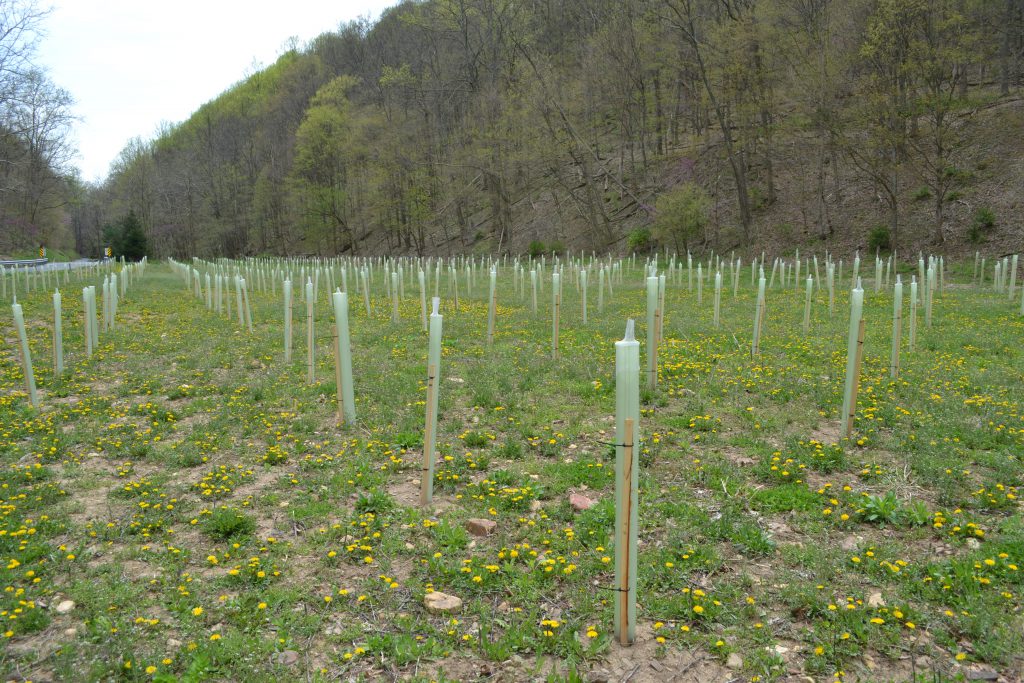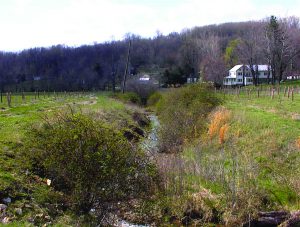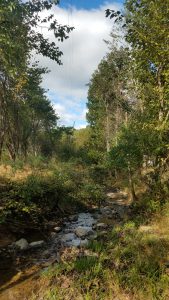Transforming with Trees: 15 Years of Monitoring Streamside Buffers

Riparian buffer planting; staff photo
All over Maryland, streams have been transformed by trees and other plants that have grown up around their channels. Trees are the natural building blocks of healthy streams, gradually forming more sheltered environments in channels previously open to trampling from cattle and muddied by fields cropped up to banks. The benefits of forest buffers continue to grow over time, making buffers a cost-effective practice that supports sustainable agriculture over the long term.
For more than 15 years, the Maryland Department of Natural Resources Forest Service has studied the effects of planting and maintaining forests alongside Maryland’s streams and rivers. Also known as riparian forest buffers, these forested areas are considered the last defense for water-ways against the harmful effects of pollution and erosion.
Marylanders are familiar with how trees and forests look; we see them practically everywhere, along our roads and highways, or in our neighborhoods and local parks. However, the early stages of planted forest buffers look quite a bit different from larger, mature forests. Buffers often are planted using year-old seedlings, 300-400 hundred per acre, because they are cost-efficient and their roots can better adapt to their new soil as they mature. Newly planted saplings are protected from animal browse with specialized tubes around each tree. These tubes allow rain and sunlight in, but protect the trees from browse and deer antler-rub.
Many buffers are planted in rows, making the critical early maintenance of mowing or spraying competing weeds and invasive species an achievable task. Foresters check survival and help landowners reinforce plantings where new seedlings are needed, switching species or tactics to meet site conditions. The usual stresses and adventures of young seedlings add randomness as the buffers mature and weaker trees are crowded out.
Over the course of a 15-year study, 88 percent of the planted buffers met tree stocking goals of 200 trees per acre, more than needed for mature forest, but a good density for young forest. Site visits found that a number of factors reduced survival, including competing vegetation, invasive pests, deer browse, drought conditions and a lack of regular maintenance. Some planted trees died but other trees filled in, introduced by birds, squirrels or the wind. The number of native plant species doubled from the earliest days of the planting to 2018. Invasive species are a problem that is worsening over time; they are appearing at faster rates than natives. Ultimately, planting a diverse mix of native trees supports native wildlife and can protect against the damaging effects of pests and disease.
Riparian forest buffers play a critical role in watersheds by trapping and transforming excess nutrients before they enter a stream. From prior research, scientists know that mature forest buffers filter and process excess nutrient runoff from agriculture and human development. In moderate to high concentrations, phosphate and nitrogen cause large algae blooms that can rob the stream of the dissolved oxygen that fish, insects and other living organisms need to survive. Annual grab samples of water from the downstream end of buffers found generally decreasing trends in nitrate and phosphate levels as the forests grew, factoring in the effects of trees along with other positive changes in farm practices and air quality within the watersheds. At roughly 15 years old, the forest buffers studied in Maryland are not yet fully mature; tree trunks still appear rather slender and the leaf canopy overhead has not completely closed to fully shade the stream below. Generally, bigger trees bring greater function, with more organic matter building up soil structure and more roots turning over and adding soil pores. Even these young trees are already making a difference. Soil infiltration rates were measured through a partnership with Hood College and researchers found that water soaked into forest buffer soils more than twice as quickly compared to the adjacent farmland.
Reviving a habitat

Before (note telephone pole); staff photo
Water quality and soil health are just the start. Streams, rivers, creeks, brooks and the like are homes to aquatic species and provide important water and food to countless other species. All living organisms need to breathe and eat in order to survive. Riparian forest buffers provide for these needs in a number of ways, from producing leaf litter and stabilizing streambeds to supporting insects at the bottom of the food chain. Trees provide shade to keep stream waters cool, and cooler water can hold more oxygen for fish and aquatic amphibians. It can take years to rebuild a stream community, and these forest buffers are just now reaching crown closure that brings fuller shade. Even so, over half of the streams saw increases from 2000 to 2017 in the diversity of insects and other invertebrates at the bottom of buffered streams and expansion of species sensitive to pollution. More significant changes are likely to take more time as the forests continue to grow up and moderate the stream environment further.
Streams running through mature forests are generally wider and shallower than in grassy areas, providing more space for the stream insects at the base of the stream food web. Forest streams also tend to be more stable, with tree roots anchoring the streambanks and a shape that reduces erosion stress. With these young buffers recently reaching crown closure, the ongoing changes in width and depth are not yet consistent.

After (note telephone pole); staff photo
Well-shaded streams provide important habitat for one of Maryland’s most treasured native species, the brook trout. Once wide-spread within the Piedmont and Appalachian regions, adult brook trout require water temperatures that average below 75 degrees, and young fish need even cooler water, below 68 degrees, to survive. Average annual temperatures are increasing over air and water, but trees can help to prevent the rapid warming that occurs along unbuffered waterways. To consider the effect of water temperature on brook trout, biologists looked at the number of times that daily temperatures were over the brook trout survival threshold temperature.
At the time of planting, most streams saw fewer suitable days for trout at the downstream end of the buffer; by 2017 downstream looked a lot like upstream—good news for trout. It was an exciting day when one of the department’s foresters saw a brook trout moving up past a recently removed barrier to fish passage and into an area of restored buffers where brook trout had never been found. Watershed resilience in action!
Getting involved
The Maryland Department of Natural Resources partners with several organizations to make adding forested buffers easier and more affordable for Marylanders. If you have farmland, the Conservation Reserve Enhancement Program pairs federal and state programs to offer cost-share and land rental payments for buffers, wetlands and rare species habitats. Landowners with more than five acres can apply for state cost-share through the Woodland Incentive Program. At a smaller scale, the Backyard Buffer Program provides interested landowners with 20 to 30 tree seedlings that can be planted along a stream or wetland. Participants can take home the infant trees and begin their own journey towards reforesting their property.
dnr.maryland.gov/trees
Article by Micah Miles, Riparian Buffer Outreach Specialist for the department’s Forest Service, and Anne Hairston-Strang, Associate Director for the department’s Forest Service.
Appears in Vol. 22, No. 2 of the Maryland Natural Resource magazine, spring 2019.


 1-888-373-7888
1-888-373-7888 233733
233733